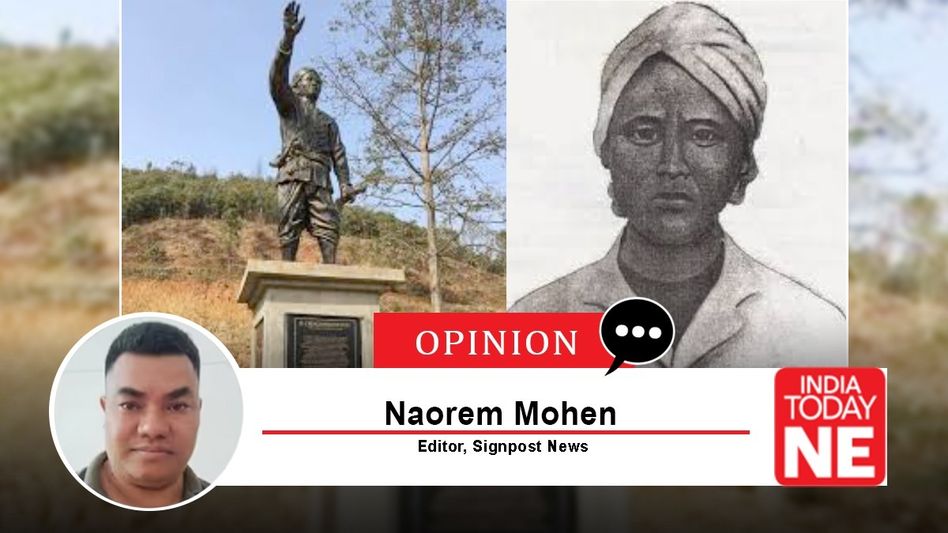Why Kuki Inpi Lies About Thadou Chief Chengjapao Doungel
On August 28, social media platforms were flooded with posts marking the martyrdom day of Thadou chief Chengjapao Doungel, a key figure in the Thadou Gaal, a resistance movement later inaccurately branded as the "Anglo-Kuki War of Independence."

On August 28, social media platforms were flooded with posts marking the martyrdom day of Thadou chief Chengjapao Doungel, a key figure in the Thadou Gaal, a resistance movement later inaccurately branded as the "Anglo-Kuki War of Independence."
The Kuki Inpi and several Kuki-affiliated social media pages have aggressively promoted Chengjapao as the organizer of a unified Kuki community uprising against British colonial feudal authority, even invoking the banner of "Azad Hind Fauj." Today, on his death anniversary, his courageous acts in defending his people from colonialists are rightfully remembered. However, the narrative pushed by these groups is riddled with distortions that demand scrutiny.
Chengjapao Doungel died in 1928, yet Kuki Inpi and similar pages have repeatedly mocked the Thadou chief by linking him to the Second World War, where the Indian National Army (INA) fought the British between 1944 and 1945—a timeline that defies historical logic given his death over a decade earlier. This blatant misrepresentation has sparked outrage, prompting the Thadou Students’ Association (TSA) to issue a press statement. The TSA honored Chengjapao’s sacrifice but fiercely contested claims by Kuki Inpi Manipur and other pages that portray him as a World War II leader or a figure in an imagined "Anglo-Kuki War." These distortions, the TSA argues, undermine his true legacy.
Pu Chengjapao Doungel, born in 1868 in Aisan village, Manipur, led the Thadou resistance against British colonial oppression during the 1917–1919 uprising, a response to forced labor recruitment for World War I. Arrested in 1919 and imprisoned for four years, he was released in 1923 but succumbed to the toll of his struggles, dying on August 28, 1928, as confirmed by the TSA. The assertion that he fought in World War II (1939–1945) is patently false, and the TSA’s statement further debunks any connection to the Azad Hind Fauj, established in 1942. Despite this, Kuki narratives persist in twisting the timeline, possibly to inflate Chengjapao’s stature or align his story with broader anti-colonial struggles for political gain.
Pu Chengjapao, chief of Aishan village, emerged as a central resistor during Thadou Gaal. He organized opposition to labor recruitment even before workers were dispatched, convening meetings to resist and, if necessary, wage war against the government. Leveraging his status as a senior Thadou chief, he sought Angami Naga support. After his uncle’s arrest by Higgins, Chengjapao visited Imphal, was briefly detained, then released to rally other recalcitrant chiefs, a task he claimed he could undertake. His efforts to persuade Chief Khilkung at Jampi failed, and instead of returning, he relocated to Haijang near Lapvomi.
Also Read: Why Must Muivah Return to Somdal After 50 Years of Exile
Ejected by Colonel Woods, Deputy Commissioner of Naga Hills, he maintained communication with other rebels, sustaining himself through raids on nearby villages. He attacked a Lapvomi post despite provocation and allied with Toljakhup and Laljashoung. Forced out again, he fortified Vahong (Wahong), continuing raids on Naga villages, aiding Tongkhulun of Chassad in a massacre at Kasom, and burning Challou Khunou. Cornered when Vahong was destroyed by the Lapvomi-Shilloi column, he surrendered to Lieutenant Perry at Tusom, facing a 15-year detention in Tezpur, Dibrugarh, or Sadiya. He was released after serving 4 years due to deteriorating health issues.
The term "Anglo-Kuki War" itself is a flashpoint of contention. Naga bodies, supported by historical records, insist it was a "Rebellion" (1917–1918), a localized conflict lasting about a year, driven by internal tribal dynamics rather than a coordinated war against the British. They allege that during this period, Kukis killed 289 Nagas and 4 Meiteis, burned 34 Naga villages, and targeted civilians, with minimal direct engagement with British forces. This view is reinforced by a 1959 letter from Chief Commissioner J.M. Raina, who noted the rebellion’s anti-British stance was not part of the Indian National Movement and highlighted Kuki raids, such as those by Chief Pachei, who killed 50 Tangkhul Nagas for refusing tribute. An RTI response from the Ministry of Home Affairs (MHA) in 2023, filed by social activist Licypriya Kangujam, found no evidence of an "Anglo-Kuki War," listing only four Kukis among Manipur’s 62 recognized freedom fighters of 1944 and 1945, none tied to this so called Kuki War event.
In contrast, Kuki sources portray it as a war of independence, erecting memorials with inscriptions like "In defence of our ancestral land and freedom." Yet, the absence of British documentation supporting this narrative, combined with evidence of intra-tribal violence, suggests the "war" label may be a retrospective rebranding to bolster ethnic pride or legitimacy. The Manipur government’s past orders to remove such memorials hint at political motivations to suppress divisive histories amid ongoing ethnic tensions.
The Naga narrative, labeling the rebellion a "savage episode" with attacks on their communities, is supported by Raina’s account of Kuki raids. Chengjapao’s imprisonment and the subsequent decline of his chiefdom—marked by a shift from defiance to submission—reflect the rebellion’s heavy toll.
Another layer of distortion lies in calling Chengjapao a "Kuki King" despite his identity as a Thadou chief. The Thadou are a major clan within the broader Kuki-Chin group, often referred to as Thadou-Kukis. The British recognized Chengjapao’s influence over multiple clans, though this was not a monarchical role but a position of authority within the decentralized chieftainship system. Labeling him a "Kuki King" today may aim to unify diverse Kuki clans under a single heroic figure, reinforcing a shared ethnic identity amid ongoing tensions in Manipur.
The motivations behind these narratives are telling. Kuki Inpi’s promotion of Chengjapao as a World War II fighter and "Kuki King" appears to be a calculated effort to claim credit for expelling the British or to showcase Kuki contributions to India’s freedom struggle. This propaganda may stem from a desire to elevate the community’s historical standing, especially in a region where ethnic identities are fiercely contested. Social media amplifies these distortions, where community pride often trumps historical accuracy, and oral traditions—rich but prone to chronological blending—fuel the narrative.
While Chengjapao’s reverence is deserved, his legacy should rest on historical truth. His leadership in the 1917–1919 uprising, his imprisonment, and his sacrifice are monumental without embellishment. Honoring him means celebrating his true contributions while fostering a nuanced understanding of the region’s complex ethnic histories.
The misrepresentation of Chengjapao as a World War II fighter and "Kuki King" reflects a blend of cultural pride, ethnic unification, and historical reinterpretation. While these narratives carry significant weight, they highlights the need for critical engagement with history to ensure his legacy is both celebrated and accurately represented.
Chengjapao Doungel stands as a towering figure of honor and resistance, his steadfast defiance against British colonial orders echoing the spirit of Haipou Jadonang, another revered leader who challenged imperial rule. His courageous leadership in organizing the Thadou resistance, despite the heavy price of imprisonment and eventual sacrifice, deserves the highest respect. For every ethnic community that endured the yoke of British colonialism, such acts of resistance must be honored and remembered with reverence. However, this tribute must be grounded in truth, free from the fabrications and lies that distort historical narratives for political gain, as done by Kuki Inpi recently.
Copyright©2025 Living Media India Limited. For reprint rights: Syndications Today









